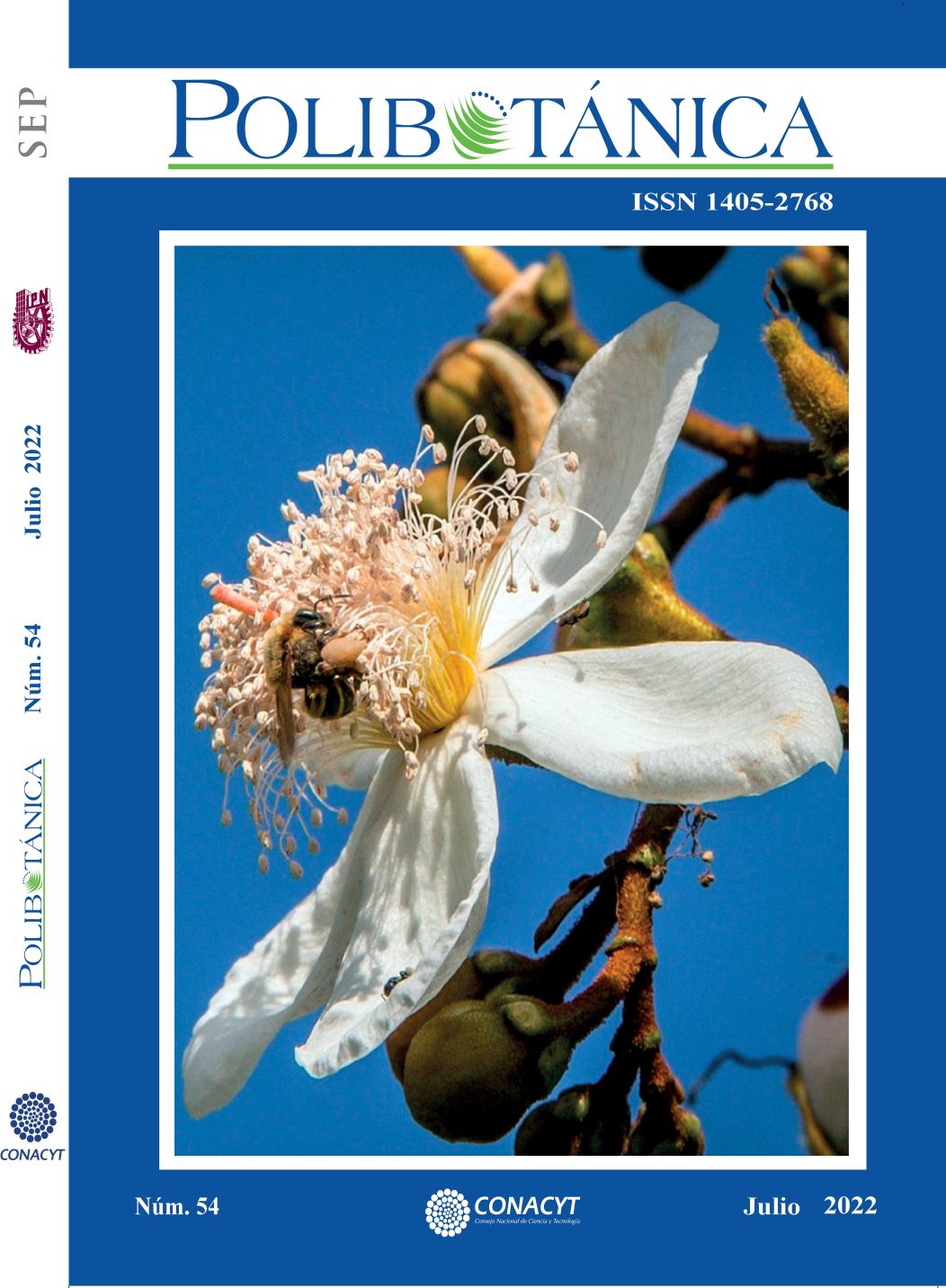Structure, floristic composition, above-ground biomass and carbon content in tropical evergreen forest in Tizimin, Yucatan, Mexico
DOI:
https://doi.org/10.18387/polibotanica.54.3Keywords:
aguada; ecuaciones alométricas; índice de valor de importanciaAbstract
The objective of the study was to characterize the horizontal structure, determine the composition of woody species, estimate the above-ground biomass and carbon content in three areas: waterhole, regeneration area and conservation area, in a tropical evergreen forest. Seventy-five sampling sites with a surface area of 1,000 m2 were established, measuring the diameter at breast height (DBH), height and crown diameter, of all individuals with DBH ≥ 2.5 cm. According to the results obtained in the diameter categories, a total of 9 categories resulted for the waterhole area, the regeneration area with 12 and the conservation area 13 categories. The species richness was as follows: for the waterhole area 45 species, the regeneration area 58 species and for the conservation area 61 species. The species with the highest index of importance value in the three areas is Piscidia piscipula. The average above-ground biomass and carbon stored was 118.78 and 59.39 ton ha-1 for the regeneration area, 166.50 and 83.25 ton ha-1 for the waterhole, and 182.58 and 91.29 ton ha-1 for the conservation area.
References
Bautista-Hernández, J., & Torres-Pérez, A. J. (2003). Valoración económica del almacenamiento de carbono del bosque tropical del ejido Noh Bec, Quintana Roo, México. Revista Chapingo Serie Ciencias Forestales y del Ambiente, 9, 69-75. Obtenido de https://revistas.chapingo.mx/forestales/ ?section=articles&subsec=issues&numero=27&articulo=389
Brown, S., Gillespie, A. J., & Lugo, A. E. (1989). Biomass estimation methods for tropical forests with applications to forest inventory data. Forest Science, 35, 881-902. doi:10.1093/forestscience/35.4.881
Cairns, M. A., Olmsted, I., Granados, J., & Argaez, J. (2003). Composition and aboveground tree biomass of a dry semi-evergreen forest on Mexico’s Yucatan Peninsula. Forest Ecology and Management, 186, 125-132. doi:10.1016/s0378-1127(03)00229-9
Chan, D. A. M. (2010). Diversidad florística y funcional a través de una cronosecuencia de la selva mediana subperennifolia en la zona de influencia de la Reserva de la Biosfera Calakmul, Campeche, México. Tesis Doctoral, Centro Agronómico Tropical de Investigación y Enseñanza (CATIE), Turrialba, Costa Rica.
Dai, Z., Birdsey, R. A., Johnson, K. D., Dupuy, J. M., Hernandez-Stefanoni, J. L., & Richardson, K. (2014). Modeling Carbon Stocks in a Secondary Tropical Dry Forest in the Yucatan Peninsula, Mexico. Water, Air, & Soil Pollution, 225, 1-5. doi:10.1007/s11270-014-1925-x
Díaz, G. J., Castillo, A. O., & García, G. G. (2002). Distribución espacial y estructura arbórea de la selva baja subperennifolia en un ejido de la Reserva de la Biosfera Calakmul, Campeche,
México. Ecosistemas y Recursos Agropecuarios, 18, 11-28. doi:10.19136/era.a18n35.235
Dupuy-Rada, J. M., Hernández-Stefanoni, J. L., Hernández-Juárez, R., Tun-Dzul, F., & May-Pat, F. (2012). Efectos del cambio de uso del suelo en la biomasa y diversidad de plantas leñosas en un paisaje de bosque tropical seco en Yucatán. Investigación Ambiental Ciencia y Política Pública, 4, 130-140. Obtenido de https://cicy.repositorioinstitucional.mx/jspui/bitstream/1003/1242/1/id26022_Dupuy _Juan.pdf
Eaton, J. M., & Lawrence, D. (2009). Loss of carbon sequestration potential after several decades of shifting cultivation in the Southern Yucatán. Forest Ecology and Management, 258, 949-958. doi:10.1016/j.foreco.2008.10.019
Esparza-Olguín, L. G. (2019). Diversidad y biomasa de la selva circundante al Volcán de los Murciélagos, en Campeche, México. Ecosistemas y Recursos Agropecuarios, 6, 79-90. doi:10.19136/era.a6n16.1986
Esparza-Olguín, L. G., & Martínez-Romero, E. (2018). Diversidad y carbono almacenado en el área forestal permanente de Álvaro Obregón, Calakmul, Campeche. Revista Mexicana de Ciencias Forestales, 9, 152-186. doi:10.29298/rmcf.v9i45.141
Fonseca, W., Rey-Benayas, J. M., & Alice, F. E. (2011). Carbon accumulation in the biomass and soil of different aged secondary forests in the humid tropics of Costa Rica. Forest Ecology and Management, 262, 1400-1408. doi:10.1016/j.foreco.2011.06.036
Garreaud, R. (2011). Cambio Climático: Bases físicas e impactos en Chile. Revista Tierra Adentro, 93, 1-14. Obtenido de http://www.dgf.uchile.cl/rene/PUBS/inia_RGS_final.pdf
Gutiérrez-Báez, C., Ortiz-Díaz, J. J., Flores-Guido, J. S., Zamora-Crescencio, P., Domínguez-Carrasco, M. R., & Villegas, P. (2011). Estructura y composición florística de la selva mediana subcaducifolia de Nohalal-Sudzal Chico, Tekax, Yucatán, México. Foresta Veracruzana, 13, 7-14. Obtenido de https://www.redalyc.org/pdf/497/49719786002.pdf
González-Iturbe, J. A., Olmsted, I., & Tun-Dzul, F. (2002). Tropical dry forest recovery after long term Henequen (sisal, Agave fourcroydes Lem.) plantation in northern Yucatan, Mexico. Forest Ecology and Management, 167, 67-82. doi:10.1016/S0378-1127(01)00689-2
Houghton, R. A., Byers, B., & Nassikas, A. A. (2015). A role for tropical forests in stabilizing atmospheric CO2. Nature Climate Change, 5, 1022-1023. doi:10.1038/nclimate2869
INEGI (Instituto Nacional de Estadística y Geografía). (2009). Prontuario de Información Geográfica Municipal de los Estados Unidos Mexicanos. Tizimín, Yucatán. Clave geodésica 31096. Obtenido de www.inegi.org.mx/sistemas/mexicocifras/datos-geograficos/31/31096.pdf
IPCC (Intergovernmental Panel on Climate Change). (2007). Cambio climático 2007: Informe de síntesis. Contribución de los grupos de trabajo I, II y III al Cuarto Informe de evaluación del Grupo Intergubernamental de Expertos sobre el Cambio Climático. Obtenido de https://www.ipcc.ch/site/ assets/uploads/2018/02/ar4_syr_sp.pdf
López-Jiménez, L. N., Durán-García, R., & Dupuy-Rada, J. M. (2019). Recuperación de la estructura, diversidad y composición de una selva mediana subperennifolia en Yucatán, México. Madera y Bosques, 25, 1-17. doi:10.21829/myb.2019.2511587
Mostacedo, B., & Fredericksen, T. S. (2000). Manual de Métodos Básicos de Muestreo y Análisis en Ecología Vegetal. Santa Cruz, Bolivia: El País.
Návar, J. (2009). Allometric equations for tree species and carbon stocks for forests of northwestern Mexico. Forest Ecology and Management, 257, 427-434. doi:10.1016/j.foreco.2008.09.028
Pan, Y., Birdsey, R. A., Fang, J., Houghton, R., Kauppi, P. E., Kurz, W. A., Phillips, O. L., Shvidenko, A., Lewis, S. L., Canadell, J. G., Ciais, P., Jackson, R. B., Pacala, S. W., Mcguire, A. D., Piao, S., Rautiainen, A., Sitch, S., & Hayes, D. (2011). A Large and Persistent Carbon Sink in the World’s Forests. Science, 333, 988-993. doi:10.1126/science.1201609
Picard, N., Saint, A. L., & Henry, M. (2012). Manual de construcción de ecuaciones alométricas para estimar el volumen y la biomasa de los árboles: del trabajo de campo a la predicción. Roma, Italia – Montpellier, Francia: Las Naciones Unidas para la Alimentación y la Agricultura y el Centre de Coopération Internationale en Recherche Agronomique pour le Développement.
Ramírez-Guardado, M. A. (2015). Estimación del carbono retenido en la biomasa aérea en una selva tropical de Yucatán, México. Tesis de Maestría, Centro de Investigación Científica de Yucatán, A.C. Yucatán, México.
Rodríguez-Laguna, R., Jiménez-Pérez, J., Meza-Rangel, J., Aguirre-Calderón, O., & Razo-Zarate, R. (2008). Carbono contenido en un bosque tropical subcaducifolio en la reserva de la biosfera El Cielo, Tamaulipas, México. Revista Latinoamericana de Recursos Naturales, 4, 215-222. Obtenido de http://revista.itson.edu.mx/index.php/rlrn/article/view/127/59
Tadeo-Noble, A. E., Valdez-Hernández, J. I., Beltrán-Rodríguez, L., & García-Moya, E. (2019). Efecto del aprovechamiento forestal sobre la estructura y diversidad arbórea en selvas tropicales de Quintana Roo, México. Bosque, 40, 129-140. doi:10.4067/s0717-92002019000200129
Zamora-Crescencio, P., García-Gil, G., Flores-Guido, J. S., & Ortiz, J. J. (2008). Estructura y composición florística de la selva mediana subcaducifolia en el sur del estado de Yucatán, México. Polibotánica, 26, 39-66. Obtenido de http://www.polibotanica.mx/ojs/index.php/polibotánica /article/view/759/982
Zamora-Crescencio, P., Rico-Gray, V., Barrientos-Medina, R. C., Puc-Garrido, E. C., Villegas, P., Domínguez-Carrasco, M. R., & Gutiérrez-Báez, C. (2017). Estructura y composición florística de la selva mediana subperennifolia en Bethania, Campeche, México. Polibotánica, 43, 67–86. doi:10.18387/polibotanica.43.3
Downloads
Published
Issue
Section
License

Polibotánica by Departamento de Botánica de la Escuela Nacional de Ciencias Biológicas del Instituto Politécnico Nacional se distribuye bajo una Licencia Creative Commons Atribución-NoComercial-CompartirIgual 4.0 Internacional.




















